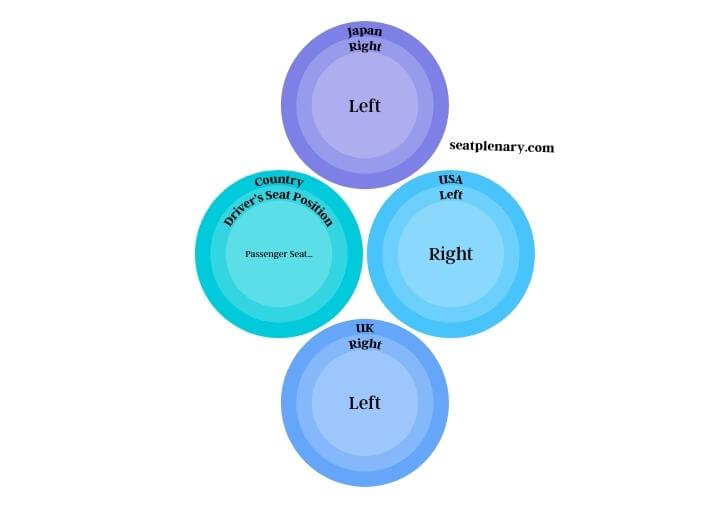The seat beside the driver is commonly referred to as the front passenger seat or the co-driver seat. This term has historical roots, with “riding shotgun” originating from the Old West, where a person would sit next to the stagecoach driver, armed for protection.
The front passenger seat in a car plays a vital role in both functionality and passenger dynamics. It’s not just a seat; it’s a position that comes with responsibilities, especially in scenarios like navigation or assisting the driver. The term ‘co-driver’ is often used in contexts like rallying, where the person in this seat plays an active role in guiding the driver. In everyday use, this seat is crucial for passenger comfort and accessibility, often mirroring the driver’s seat in terms of adjustability and features.

Behind the driver, the back passenger seat is designed with a focus on comfort and safety, especially in family cars or vehicles used for group travel. The space between the front seats, commonly known as the center console, serves as a practical area for storage and additional controls. Each seat in a vehicle, from the front passenger seat to the back, is designed with specific purposes in mind, balancing safety, comfort, and utility to enhance the overall driving experience.
The Historical Roots of ‘Riding Shotgun’
The term ‘riding shotgun’ is deeply rooted in American history, tracing back to the days of stagecoaches. During this era, a person would sit next to the driver, armed with a shotgun to protect against highwaymen and bandits. This role was pivotal for the safety of the passengers and the goods being transported. Over time, the phrase evolved beyond its literal meaning, permeating popular culture and media. It came to symbolize a position of readiness and vigilance, often depicted in Western films and literature.
In other cultures, similar phrases with different historical backgrounds have emerged, reflecting the universal concept of a protector or a trusted companion in the passenger seat. This evolution highlights the seat’s significance beyond its physical presence, symbolizing trust and responsibility.
Roles and Responsibilities of the Front-Seat Passenger
The front-seat passenger, often underrated, plays a crucial role in ensuring a safe and efficient journey. This role extends beyond merely occupying a seat; it involves active participation in journey management. The passenger is often tasked with navigating, managing music or climate controls, and providing company to the driver, reducing the risk of driver fatigue.
Safety is paramount, and the front-seat passenger must be vigilant, helping to spot potential hazards and assisting in decision-making. This role also carries a social dynamic, often filled by a trusted friend or family member, highlighting the seat’s importance in fostering interpersonal connections during travel.
Design and Functionality of the Co-Driver’s Seat
The co-driver’s seat is a marvel of ergonomic design and technological advancement. Modern vehicles equip this seat with features aimed at maximizing comfort and safety. These include adjustable positions, lumbar support, and even advanced options like massage functions and climate control.
This seat often mirrors the driver’s seat in functionality but is tailored for the passenger’s comfort. Its design considers long journeys, ensuring that the passenger can relax without compromising on safety features like airbags and seatbelts. The evolution of this seat reflects the automotive industry’s recognition of the passenger’s importance in the driving experience.
The Passenger Seat: A Perspective on Vehicle Layout
The design and placement of the passenger seat vary significantly across different cultures and vehicle types. In some countries, the driver’s seat is on the left, while in others, it’s on the right, directly influencing the position of the passenger seat. This variation affects not just the vehicle’s layout but also the passenger’s experience.
Global Variations in Car Design
| Country | Driver’s Seat Position | Passenger Seat Position |
| USA | Left | Right |
| UK | Right | Left |
| Japan | Right | Left |

These differences reflect the diverse approaches to automotive design and the cultural nuances that influence them. The passenger seat’s position plays a vital role in the vehicle’s overall ergonomics and passenger comfort.
Behind the Wheel: Understanding the Seat Behind the Driver
The seat directly behind the driver is often overlooked but plays a significant role in vehicle design and passenger experience. This seat is crucial for accommodating additional passengers, and its design considers various factors like legroom, visibility, and ease of access.
In different vehicle types, from sedans to SUVs, the design of this seat varies to optimize space and comfort. For instance, in minivans, this seat might offer additional features like reclining capabilities or individual entertainment systems.
Seat Features in Different Vehicle Types
| Vehicle Type | Legroom | Reclining Feature | Entertainment System |
| Sedan | Moderate | No | Sometimes |
| SUV | Ample | Yes | Often |
| Minivan | Ample | Yes | Often |
The design of this seat is integral to the vehicle’s overall safety, ensuring that all passengers are protected in the event of an accident.
Frequently Asked Questions (FAQs)
Is the Front Passenger Seat Safer Than the Back?
Safety in vehicles is a complex topic, often leading to debates about the safest seat. Traditionally, the back seat was considered safer due to its distance from the common impact zones. However, recent advancements in car safety technology, such as airbags and reinforced structures, have significantly improved the safety of the front passenger seat. Studies show that with these advancements, the front seat can be just as safe as the rear in certain scenarios. Nevertheless, the safest seat also depends on other factors like the vehicle’s design, the presence of airbags, and the nature of a potential collision.
How Does the Front Passenger Seat Impact Insurance?
The presence and use of the front passenger seat can influence car insurance policies and rates. Insurance companies often consider the overall safety features of a vehicle, including those related to the passenger seat, like airbags and seatbelt systems. A car equipped with advanced safety features, including those for the front passenger, might qualify for lower insurance premiums. Additionally, the behavior of passengers, such as wearing seatbelts, also plays a role in determining insurance rates and coverage, especially in the event of an accident.
Can the Front Passenger Seat Be Modified for Accessibility?
Modifying the front passenger seat for accessibility is a crucial aspect for many drivers and passengers with disabilities. Various adaptations can be made, such as swivel seats, seat lifts, and adjustable seating positions, to accommodate individuals with mobility challenges. These modifications are designed to make entering and exiting the vehicle easier and more comfortable. It’s essential to ensure that any modifications comply with safety standards and do not interfere with the vehicle’s existing safety features.
What Is the Legal Age for Sitting in the Front Passenger Seat?
The legal age for sitting in the front passenger seat varies by region and is governed by local traffic laws. In many places, children under a certain age or below a specific height and weight threshold are required to sit in the back seat, primarily for safety reasons. This is due to the potential risks posed by front airbags to younger children in the event of a collision. It’s important for drivers to familiarize themselves with and adhere to these regulations to ensure the safety of all passengers.
How Does the Front Passenger Seat Affect Fuel Efficiency?
The weight and distribution in a vehicle, including that of the front passenger seat, can impact its fuel efficiency. Additional weight generally leads to increased fuel consumption. However, the effect of a single passenger seat is relatively minimal compared to the overall weight of the vehicle and its contents. The impact becomes more noticeable when the seat is occupied or when heavy items are placed on it. For optimal fuel efficiency, it’s advised to avoid unnecessary weight in the vehicle.
What Are the Latest Technological Advancements in Front Passenger Seats?
The front passenger seat has seen significant technological advancements aimed at enhancing comfort, safety, and user experience. Modern seats often come with features like adjustable lumbar support, heating and cooling options, and programmable positions. Safety has also been a major focus, with improvements in airbag technology and integration with vehicle safety systems. Some high-end models even include massage features and advanced materials for added comfort during long journeys. These advancements reflect the ongoing innovation in vehicle design and passenger experience.
In summary, the seat beside the driver, often colloquially referred to as ‘riding shotgun,’ has a rich history and plays a multifaceted role in the driving experience. From its historical roots as a position of protection to its modern-day role in vehicle design and passenger comfort, this seat is more than just a place to sit. It reflects cultural nuances, technological advancements, and the evolving dynamics of the driver-passenger relationship.
